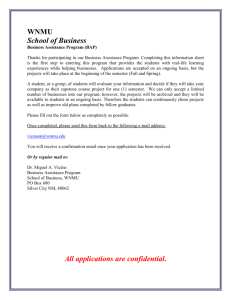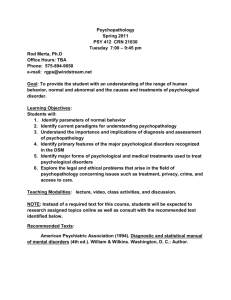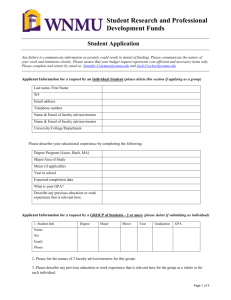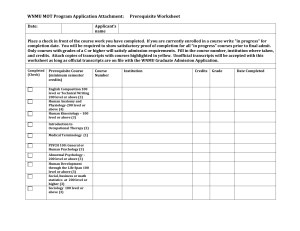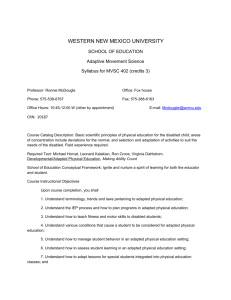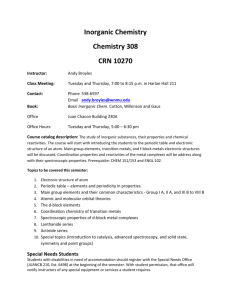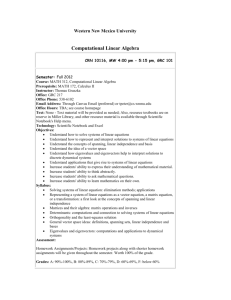SPED_570_SYLLABUS - Western New Mexico University
advertisement
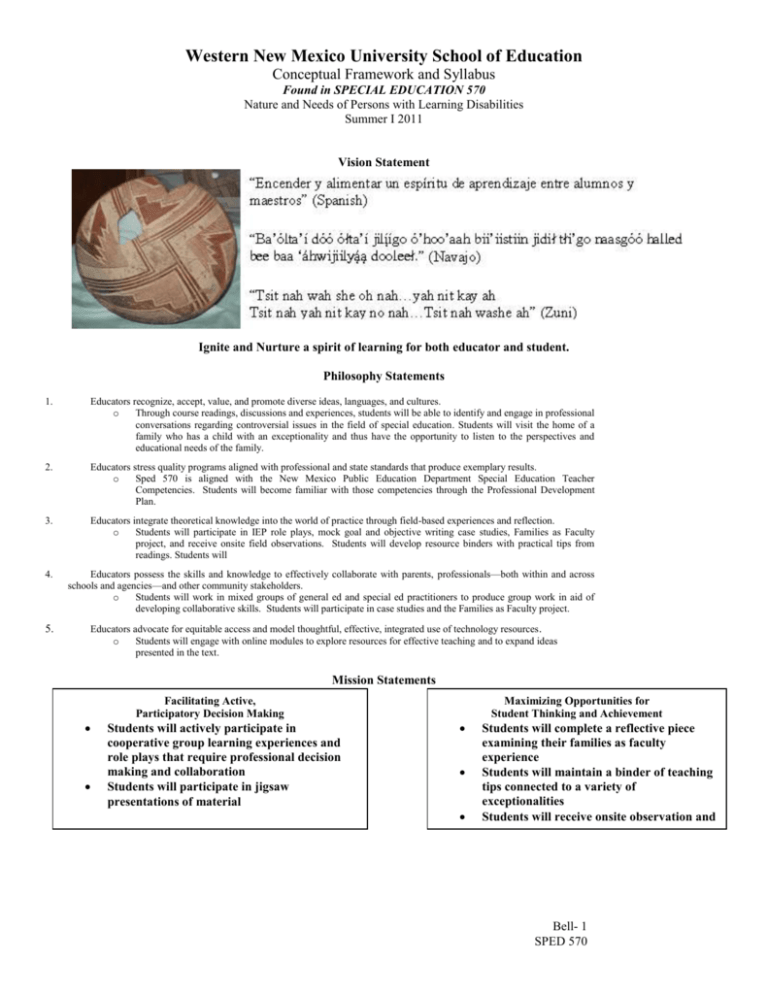
Western New Mexico University School of Education Conceptual Framework and Syllabus Found in SPECIAL EDUCATION 570 Nature and Needs of Persons with Learning Disabilities Summer I 2011 Vision Statement Ignite and Nurture a spirit of learning for both educator and student. Philosophy Statements 1. Educators recognize, accept, value, and promote diverse ideas, languages, and cultures. o Through course readings, discussions and experiences, students will be able to identify and engage in professional conversations regarding controversial issues in the field of special education. Students will visit the home of a family who has a child with an exceptionality and thus have the opportunity to listen to the perspectives and educational needs of the family. 2. Educators stress quality programs aligned with professional and state standards that produce exemplary results. o Sped 570 is aligned with the New Mexico Public Education Department Special Education Teacher Competencies. Students will become familiar with those competencies through the Professional Development Plan. 3. Educators integrate theoretical knowledge into the world of practice through field-based experiences and reflection. o Students will participate in IEP role plays, mock goal and objective writing case studies, Families as Faculty project, and receive onsite field observations. Students will develop resource binders with practical tips from readings. Students will 4. Educators possess the skills and knowledge to effectively collaborate with parents, professionals—both within and across schools and agencies—and other community stakeholders. o Students will work in mixed groups of general ed and special ed practitioners to produce group work in aid of developing collaborative skills. Students will participate in case studies and the Families as Faculty project. 5. Educators advocate for equitable access and model thoughtful, effective, integrated use of technology resources . o Students will engage with online modules to explore resources for effective teaching and to expand ideas presented in the text. Mission Statements Facilitating Active, Participatory Decision Making Students will actively participate in cooperative group learning experiences and role plays that require professional decision making and collaboration Students will participate in jigsaw presentations of material Maximizing Opportunities for Student Thinking and Achievement Students will complete a reflective piece examining their families as faculty experience Students will maintain a binder of teaching tips connected to a variety of exceptionalities Students will receive onsite observation and receive feedback on instructional strategies Bell- 1 SPED 570 WESTERN NEW MEXICO UNIVERSITY GALLUP GRADUATE STUDIES CENTER EDUC 570: Summer I 2011 INSTRUCTOR Wade Bell, BBA, MAT, MA COMMUNICATIONS WNMU: (505) 722-3389 E-mail: wbell@gmcs.k12.nm.us I. COURSE LOCATION: classroom E II. COURSE TIME: 5:00 pm to 9:00 pm Monday Wednesday Friday III. 6/1/2011 6/13/2011 6/10/2011 6/8/2011 6/20/2011 6/17/2011 6/15/2011 6/27/2011 6/24/2011 OFFICE HOURS Available upon request at any time from 9:00 am to 7:00 pm 6/22/2011 6/29/2011 COURSE DESCRIPTION: This course provides teachers with information which will assist them to understand the nature of learning disabilities from an interdisciplinary perspective. The focus will be on the identification, characteristics, and education of children with learning disabilities. IV. COMPETENCIES and COURSE OUTCOMES: New Mexico Public Education Department Special Education Teacher Competencies: As a result of the successful completion of this course, the student will possess the following competencies as described in the following New Mexico special education licensure standards: New Mexico Public Education Department Teacher Competencies: Define the term “Specific Learning Disability” (SLD) Identify the general characteristics, etiologies, and learning styles associated with learning disabilities. Describe current theories and research for education of students with learning disabilities. Demonstrate skills needed for effective advocacy on behalf of students and their parents. Describe rationale necessary to determine a child’s least restrictive environment (LRE) Describe knowledge in facilitating least restrictive environment (LRE) Describe medical and health needs commonly found among persons in special populations and their impacts on learning. Identify and describe programs and assistive technology that could enhance functioning. Demonstrate sensitivity to New Mexico’s unique linguistic and cultural diversity. Bell- 2 SPED 570 V. DATE June 1 June 8 June 10 June 13 June15 COURSE SCHEDULE: TOPIC Welcome and Introductions Course Overview and essential questions; norms & language Historical Concepts: Introduction to SPECIAL EDUCATION Medical Interface Definition of SLD Controversial issues in identification and labeling Causes of learning disabilities Neurological factors Medical factors Environmental factors Estrogenic factors Processing differences Cultural factors Gifted/SLD (Co-morbidity) Characteristics of people with LD Eligibility for special education Laws/IDEA RtI (Response-to-Intervention) Referral procedures Development of the IEP (Individual Education Plan) Guest Speaker: Mary Lindenmeyer Prevention and interventions in early childhood. Parents and families Adults with disabilities Guest Speaker: Shannon McFarland Teaching language, reading, writing and math in a pullout or inclusion setting. Response-to-Intervention Three-Tier Model of Interventions Accommodations Modifications READINGS & ASSIGNMENTS No Assignment Hallahan, Chapters 1 and 2 Website Presentations Hallahan, Chapter 3 Website presentations Hallahan, Chapters 4, 5, and 6 Website Presentations Hallahan, Chapters 10, 11, and 12 Midterm Assignment: Action/Decision flowcharts are due. Article: Responsiveness to Intervention in the SLD Determination Process Hallahan, Chapters 13, and 14 Website Presentations June 17 Teaching language, reading, writing and math in a pullout or inclusion setting. (Continued) June 20 IEP presentations for Jamal and Shannon IEPs and presentations due Presentations June 22 June 24 June 27 Behavioral Problems associated with students with learning disabilities Teaching desired behaviors in an inclusion setting. Crisis Prevention Intervention Day 1 Training Only Participation in general education Legal mandates according to IDEA No Child Left Behind Hallahan, Chapters 7, 8, and 9 CPI training materials Hallahan, Chapter 15 RtI Lesson Plans are due Presentations ½ class. June 29 Presentation of an RtI lesson from a scientifically researched process. RtI presentations ½ class Final Project: The Sky is the Limit due Project Presentations (1/2 Bell- 3 SPED 570 Final Thoughts will present at stations other ½ will tour/switch later on) VI. ASSIGNMENTS: Website Presentations and Handouts Midterm Assignment: Action/Decision Flowchart Individualized Education Plan (SLD: Focus on either Jamal or Shannon) RtI lesson plan and presentation in reading, writing or math Final Assignment: The Sky is the Limit! (In-Depth Study) VII. 20% 20% 20% 20% 20% ASSIGNMENTS (full descriptions & specific rubrics will be given out in class) a. Website presentations and handouts: A group of two (a few with three) students will choose a website from the following list: Learning Disabilities Association of America http://www.ldanatl.org/ GreatSchools Inc. http://www.greatschools.org/special-education.topic?content=1541 Learning Disabilities Organization http://www.learning-disabilities.org/learn3.html Council for Exceptional Children http://www.cec.sped.org/ National Institute of Mental Health http://home.hiwaay.net/~garson/learnd_nimh.htm National Dissemination Center for Children and Youth with Disabilities http://nichcy.org/ National Association for the Education of Young Children http://www.naeyc.org/ LD Online http://www.ldonline.org/ Your ADD/ADHD Newsletter http://www.youradhdnewsletter.com/ American Speech-Language-Hearing Association http://www.asha.org/ This partnership will prepare a 10 minute presentation on one the aforementioned websites. The partnership, in their presentation, will a) describe to the class what the website is about, b) explain who the intended audience is for the website, c) describe what information is on the site, and d) emphasize how the information can be used to support a special education teacher in their practice. The partnership will develop a handout that will be given to each student in the classroom, including the instructor, and should be a guide to what is in the website that will be useful for a practicing teacher of students with learning disabilities. b. Midterm Assignment: Action/Decision Flowchart (Start after Chapter 3) Bell- 4 SPED 570 Within a group, the members will develop an Action/Decision Flowchart that will be useful in helping one determine what steps to take in assisting a student who exhibits learning disability characteristics. You will use the following questions to guide your thinking: 1. How do evolving laws and policies influence assessment planning and implementation? 2. What are the functions of school systems in the structure of special education? 3. How are student assessment results used to promote positive learning results, adapt/modify learning environments, and incorporate appropriate learning technologies, while taking into consideration general and special education curricula and cultural/linguistic factors? 4. What are the ethical principles of measurement and assessment related to screening, referral, eligibility, program planning, instruction, and placement for individuals with learning disabilities? Purpose To demonstrate your understanding of the sequential steps in the decision making process as required by federal legislation To organize this information in a graphic manner in order to compare the differences between the two labeling options within the law To help you retain the information and use it efficiently in explaining the process to others What is an Action/Decision Flowchart? A Flowchart is defined as a pictorial representation presenting, describing, or analyzing a process being studied or even used to plan stages of a project. This is done by drawing small boxes which represent steps or decisions in a chain of steps or decisions. These boxes are connected to other boxes by lines and arrows which represent sequence and dependency relationships (i.e., X must be done before Y can be done). Flowcharts tend to provide people with a common language or reference point when dealing with a project or process. How to make an Action/Decision Flowchart: 1. State the Problem(s) 2. Identify Decision(s) 3. Identify Sources of Input 4. Specify Constraints 5. Define Decision Rules/Parameters o Clearly describe student difficulties in specific area(s) o Create two flowcharts, one down each side of each margin on the page o Use extensive sidebars to explain timelines, roles, pitfalls, programmatic suggestions, etc o Use colors and shapes to enhance understanding and illustrate connections o Create the document to be used as a communication tool o Include information to demonstrate complete understanding of legal process for assessment planning and instructional implementation o Detain how assessment results are used to promote learning environments Bell- 5 SPED 570 o Includes all due process principles protecting civil rights Example of an Action/Decision Flowchart: c. IEP for Jamal or Shannon: The class will be divided into two or more groups, depending on the size, to write an Individualized Education Program (IEP) for either Jamal or Shannon, one of the two students that are discussed throughout the text within the case studies. Each group will be given additional information on their particular student subject. An IEP will be developed and presented to the class using the information from the text and a diagnostic report that I provide. An emphasis for the IEP’s grade will be given to the rationale used by the team to explain each student’s present level of performance (PLP) data, their goals and objectives, the least restrictive environment the student will be placed in, appropriate accommodations to help the student succeed in class, and prior written notice notes based on the information gained through the text and diagnostic reports. The IEP will be written during various segments of class time and during out-of-class time that the group decides might be necessary. The presentation of the IEP will be conducted on the night of June 20, 2011. d. RtI Lesson Plan: Develop a lesson plan, using information that you have learned throughout the class to use in your classroom this next school year. The lesson must be typed and include the following information: i. Time frame ii. What do you want students to learn? Bell- 6 SPED 570 iii. Curriculum standards addressed in this lesson iv. IEP goals/objectives v. Modifications vi. Materials vii. Preparation of Environment viii. Lesson Description ix. Method of Assessment x. Professional reflection You will turn the lesson plan in on June 29, 2011 along with presenting the lesson to the class. Part of this project will require you to entertain the class during the final night so be as creative and engaging as humanly possible. e. Final Assignment: The Sky is the Limit! Students will have a variety of options for in-depth study in some aspect of the area of learning disabilities. You may choose to write a position paper, conduct a research study, present a PowerPoint presentation, create a web page, write a grant, or work in a group on a class presentation. Topics may include but are not limited to: Transition for Preschoolers and concerns with young children, Transition/ Adults with LD & School to Work, Placement Options, Whole Language & Constructivism with Children with LD, Attention Deficit Disorder, Definitions & Interventions for Attention, Technology for Students with LD, Parent-School Relationship, Reading Issues and LD, Phonemic/Phonological Awareness, Study Skills, What is Feels Like to have a Learning Disability, and Relationship of LD to other Concerns (Multiculturalism, English as a Second Language, Students with other disabilities). Grant Writing to fund a Resource Room. VIII. REQUIRED TEXTS: American Psychological Association. (2010). Publication manual of the American Psychological Association (6th ed.) Washington, DC. Hallahan, D. P, Lloyd, J. W., Kauffman, J. M., Weiss, M. P., & Martinez, E. A. (2005). Learning disabilities: Foundations, characteristics, and effective teaching. Boston, MA: Pearson. IX. IMPORTANT NOTES Services for students with disabilities are provided through the Academic Support Center’s DISABILITY Disability Services Office in the Juan Chacon Building, Room 220. Some examples of the SERVICES AT Bell- 7 SPED 570 WNMU INFORMED CONSENT APA STYLE TARDIES AND ABSENTEES LATE WORK INCOMPLETE POLICY WNMU Student Code of Conduct assistance provided are: audio materials for the blind or dyslexic, note takers, readers, campus guides, audio recorders, a quiet testing area, and undergraduate academic tutors. In order to qualify for these services, documentation must be provided by qualified professionals on an annual basis. Disability Services forms are available in the Academic Support Center. The Disability Services Office, in conjunction with the Academic Support Center, serves as Western New Mexico University's liaison for students with disabilities. Some students may choose to disclose personal information during class. Therefore, it is important that all classmates agree to keep the information discussed in class confidential. Following APA Format: It is imperative that you are familiar with, and can successfully demonstrate, APA format. This includes (a) being able to clearly express your ideas, (b) using proper grammar, punctuation, spelling, capitalization, abbreviations, (c) using appropriate headings and levels (if deemed appropriate in your paper), and (d) appropriately citing materials in both text and in the reference list. Be aware that APA has now published a 6th edition. If you are having difficulties with graduate level writing requirements; please make an appointment to visit the WNMU-GGSC writing center. Abbreviated guide available on line www.wnmu.org/support/apa.htm I expect you to come to every class well prepared and ready to participate in an informed manner. Because this class is largely experiential, it is imperative that you attend each class session. This includes (a) coming to class and (b) returning from breaks, on time. According to the WNMU Attendance Policy (p. 63 of 2010-2011 catalog), if you miss more than 3 hours of class (one session), you can be dropped from the course. Please visit with me or call BEFOREHAND if you anticipate being absent from, or tardy to, class. You are allowed one excused absence but will have to complete an additional project to make up the date. Missing two or more classes will result in a loss of 10% from your final grade per class. Your work is due on the date indicated on the syllabus. If you are absent when an assignment is due, it is your responsibility to turn in the work the following business day. Do not wait until the next class to turn in your work, as this will substantially decrease your grade. If you want an extension on an assignment, you must contact me in advance. Extensions may result in the lowering of the grade on the assignment by one letter grade (10%). Each student is responsible for maintaining copies of all completed assignments. Because humans and computers are not error-proof, I advise that you save often when writing papers, and once completed, save one copy to disk and one as a hard copy WNMU’s policy statement begins: “The grade of ‘I’ is given for course work that could not be completed due to circumstances beyond the student’s control…” (pg. 46 of 2000-2001 catalog). I interpret this to mean a serious illness or accident, not poor planning. If a significant crisis prevents your timely completion of the requirements of this course, please make an appointment with me. I have included my work number and e-mail address for your convenience. Once an Incomplete is given, it is your responsibility to complete the work according to the parameters of the deadline (see university catalog). The university computer automatically changes an “I” to an “F” when the deadline passes. All WNMU- Gallup students are required to sign a statement that you have read and understand the requirements of the WNMU Student Code of Conduct. http://www.wnmu.edu/univ/StudentHandbook/StudentHbk98.html Bell- 8 SPED 570 WNMU Policy on Academic Integrity You are expected to observe standards of honesty and integrity in academic work completed at WNMU. In this course, you will be penalized for violations of the Academic Integrity policy. Please refer to pages 60 and 61 of the 2008-2009 Catalog. Cheating Plagiarism Violations include any behavior that misrepresents or falsifies a student’s knowledge, skills or ability with the goal of unjustified or illegitimate evaluation or gain. Such violations include two broad categories: (1) cheating and (2) plagiarism, whether intentional or not. Cheating is understood to mean unauthorized collaboration with others, copying the work of another, or any action that presents the work of others to misrepresent the student’s knowledge, skills, or ability. Plagiarism includes, but is not limited to, the intentional or unintentional representation of another’s work as one’s own without proper acknowledgement of the original author or creator of the work, failure to quote and/or cite sources, providing or receiving unauthorized assistance in the preparation of any academic work, the fabrication of sources or information, or submitting the same work for more than one course/instructor without the permission of the current course instructor. To proactively familiarize yourself with how to avoid plagiarism, see http://www.plagiarism.org/learning_center/what_is_plagiarism.html The consequence for all violations in this course is failure of the course. WNMU Communication policy and Student email Accounts WNMU is going “paperless” for official communication to students. WNMU’s policy requires that all official communication to students (eg. Semester grades, financial information, notifications regarding your billing account) be sent via Mustang Express. As a result, all communication related to your enrollment at WNMU and class communication – including changes in assignments and grades – will be sent to your wnmu.edu student email address. This is accessed through Mustang Express on the WNMU or GGSC home page. It is very important that you access your Mustang Express e-mail periodically to check for correspondence from the University. If you receive most of your email at a different address you can forward your email from Mustang Express to your other address. Example: Martin Classmember was assigned a WNMU email address of classmemberm12@wnmu.edu but Martin would rather receive his emails at his home email address of martinclass@yahoo.com Martin would follow the direction provided at http://www.wnmu.edu/campusdocs/direction%20for%20forwarding%20email.htm WNMU Policy on Email Passwords: WNMU requires that passwords for access to all of the protected software, programs, and applications will be robust, including complexity in the number of characters required, the combination of characters required, and the frequency in which passwords are required to be changed. Minimum complexity shall include: * Passwords shall contain at least six (6) characters. * Passwords shall contain at least one capital (upper case) letter, and at least one symbol (numbers and characters such as @ # $ % & *). * Passwords shall be changed at least every 90 days. (8/6/08) Weather and Unforeseen Circumstances The schedule and procedures in this course are subject to change in the event of extenuating circumstances. If you think classes may be cancelled due to weather conditions, call WNMUGGSC at 505 722-3389 and listen to local radio stations, TV channel 7 or 4, as well as check http://ggsc.wnmu.edu for a news update on the home page. You might also check WebCT for a faculty news announcement. Bell- 9 SPED 570
